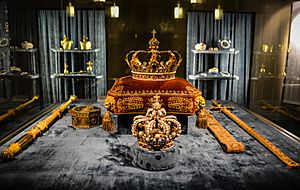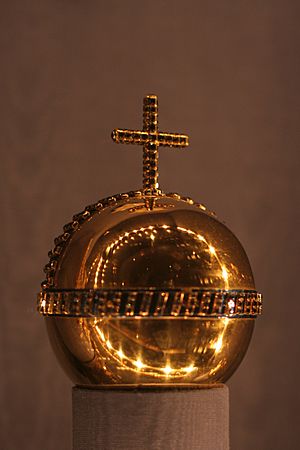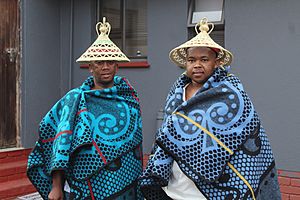Regalia facts for kids
Regalia are the special items, symbols, or fancy clothes that show someone is a king, queen, or other ruler. These items also represent the special rights and powers a ruler has. The word "regalia" comes from a Latin word meaning "royal."
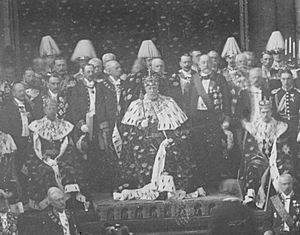
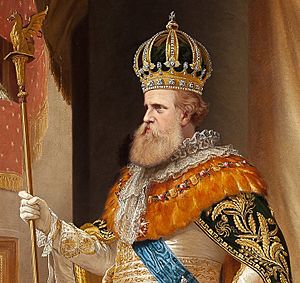
What Are Royal Regalia?
Regalia are like a ruler's special uniform and tools. They are a visual way to show that someone is in charge of a country or kingdom. Sometimes, these symbols are also linked to gods or goddesses, making the ruler seem even more powerful or connected to the divine.
Crown Jewels: Sparkle and History
The term "crown jewels" often refers to the most important regalia items. These are usually very valuable, made from precious materials, and beautifully crafted. They are used for big events like coronations, which are ceremonies where a new ruler is officially given their power. Crown jewels can be very old, passed down through many generations of rulers.
Many cultures and kingdoms have their own unique sets of regalia. Here are a few examples:
- The Honours of Scotland
- The Nigerian Royal Regalia
- The Three Sacred Treasures of the Emperor of Japan
- The Imperial Regalia of the emperors and kings of the Holy Roman Empire
- The French Crown Regalia
Even though each set is special, many regalia items are similar across different cultures.
Types of Royal Regalia
Rulers use many different items to show their power and status.
Headwear: Crowns and More
- Crowns: These are the most famous symbols of royalty. They can be simple or very fancy, often decorated with jewels.
- Diadems and tiaras: These are types of decorative headbands, sometimes worn instead of or with a crown.
- Cap of Maintenance: A special hat often worn by monarchs during ceremonies.
Royal Clothes and Jewelry
- Armills: These are special bracelets.
- Coronation mantle: A long, flowing cloak, often made of expensive fabric like ermine fur, worn during coronations.
- Gloves: Special gloves can also be part of the royal outfit.
- Barmi (Бармы): A fancy collar with precious medallions sewn onto it, used in old Russia.
- Rings: These can symbolize a ruler's connection to their country, like a "marriage" to the state. Some rings are also signet-rings, used to stamp official documents.
Hand-Held Symbols of Power
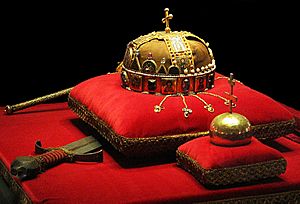
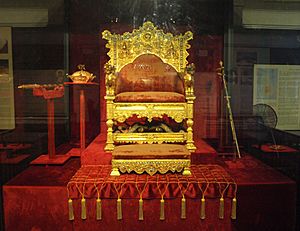
- Orb: A ball with a cross on top, symbolizing the ruler's power over the world under God.
- Scepter: A decorated staff or rod, showing authority. The French Hand of Justice is a famous type of scepter.
- Mace: A heavy club, often decorated, used as a symbol of authority.
- Sword: Swords represent justice, protection, and military power. Examples include the Sword of Justice or the Sword of State.
- Other weapons: In some cultures, daggers, spears, or special royal knives (like the kris in Malay traditions) are also regalia.
- Crook and flail: Ancient Egyptian symbols of kingship.
- Fly-whisk: In some cultures, like Japan, a fly-whisk can be a symbol of power.
- Seals: In China, special seals like the Heirloom Seal of the Realm showed the emperor's authority, believed to come from the "Mandate of Heaven."
Other Important Symbols
Regalia can also represent important qualities or virtues that a ruler should have.
For example, the Imperial Regalia of Japan are called the "Three Sacred Treasures" (Japanese: 三種の神器, romanized: Sanshu no Jingi). They include:
- The sword, Kusanagi (草薙剣), which stands for valor (bravery). It is kept at Atsuta Shrine in Nagoya.
- The jewel or necklace of jewels, Yasakani no magatama (八尺瓊曲玉), which stands for benevolence (kindness). It is kept at Kokyo in Tokyo.
- The mirror, Yata no kagami (八咫鏡), which stands for wisdom. It is kept in the Ise Shrine in Mie Prefecture.
Since 690 AD, these items have been a central part of the Japanese emperor's enthronement ceremony. They are traditionally only seen by the emperor and certain priests.
Coronation Items
Some regalia are specifically used during the official ceremony where a new ruler takes their place (an enthronement or coronation). These items can include:
- Anointing tools: A special container (ampulla) holding holy oil and a spoon to apply it. Some countries, like Norway and Sweden, use an anointment horn instead.
- A Bible: Used for the monarch to swear their oath as the new ruler.
- Coronation stones: Like the Stone of Scone or Lia Fáil, which are ancient stones used in coronation ceremonies.
Family Regalia
Besides the ruler, close family members, like a queen or a crown prince (the next in line for the throne), might also have their own special items, especially crowns, to share in the royal display.
Special Colors
Sometimes, certain colors are reserved only for royalty.
- In the Roman Empire, the color Tyrian purple was extremely expensive and mostly used by the emperor and high-ranking officials.
- In ancient China, the color yellow was reserved for the emperor. Yellow symbolized gold, wealth, and power. It also represented the center of the universe in Chinese beliefs, which fit the emperor's role. Ordinary people were not allowed to wear all-yellow clothes.
Additional Royal Displays
Other items or actions can add to the royal display:
- Umbrellas or canopies: Large, decorated covers held over the ruler.
- Fans: Used in some cultures.
- Standards: Special flags representing the ruler or kingdom.
- Maces: Used in processions.
- Music: Special songs or fanfares, or specific instruments like silver trumpets, played only for the ruler. In Malaysia, a special orchestra called the Nobat orchestra is needed for a valid coronation.
Other Types of Regalia
Regalia aren't just for kings and queens!
Republics
In countries that are republics (like the United States, which has a president instead of a king), the presidential sash is often used. This is a special ribbon worn across the body by the head of state, especially common in Latin American countries. It serves a similar purpose to royal regalia, showing who is in charge.
Academic Regalia
Academic dress is the traditional clothing worn by people at universities, especially when they graduate or are part of special ceremonies. This includes gowns, caps (like mortarboards), and hoods. In the United States, it's often called "academic regalia."
Other Examples
Another example of non-royal regalia is the traditional clothing worn by Native American and First Nations peoples for ceremonies, such as Pow Wow dancing. These outfits are very important for their culture and traditions.
See also
- Crown jewels
- Papal regalia and insignia
- Regalia of Norway
- Regalia of Sweden
- Regalia of the Russian tsars
- Royal Family
- Throne



